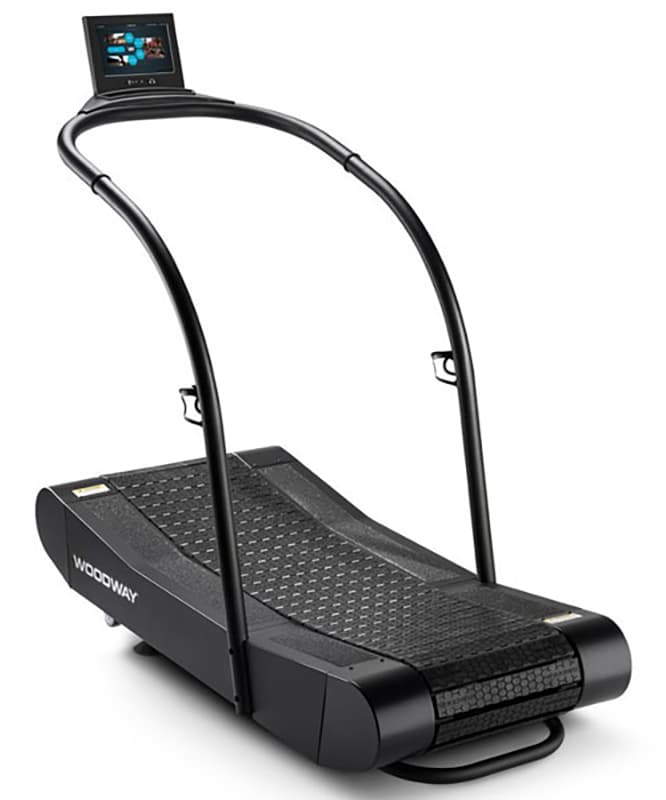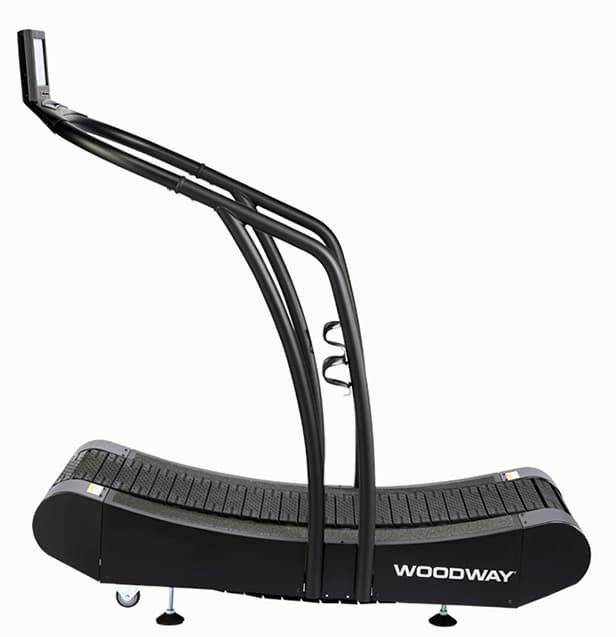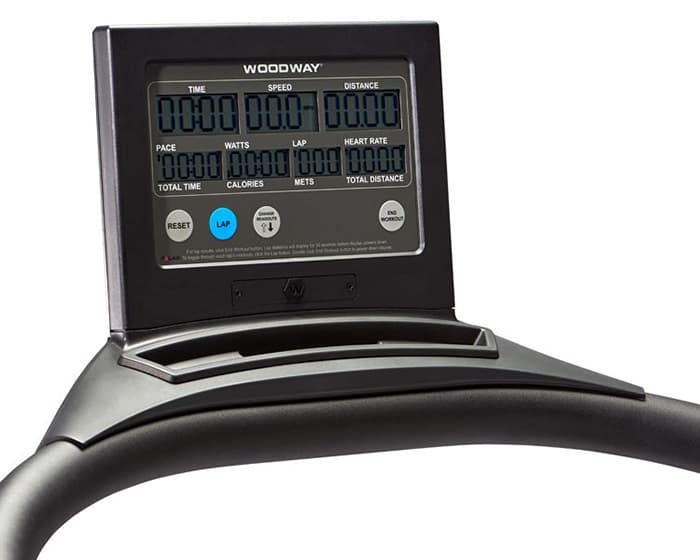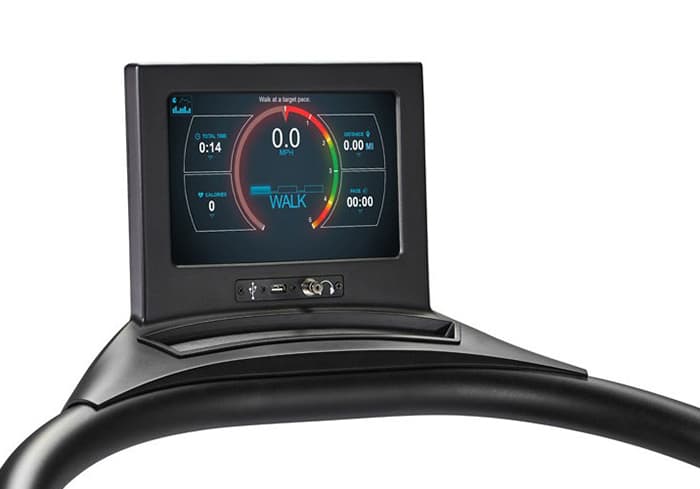The Woodway Curve is the original non-motorized curved treadmill designed in Germany in 1974. This manual treadmill has set the bar for all subsequent models and revolutionized the treadmill industry with its curved shape and slat belt design. The Woodway Curve is a solid, German-engineered treadmill designed to facilitate proper running form that mimics overground running. The curved shape is initially challenging for new users and many runners feel unstable on the Curve until they get used to a new gait pattern and upright running position. This manual treadmill is targeted for conditioned and advanced home users who want the ultimate high-end treadmill in their home. It is also routinely used in private, boutique and commercial training programs for professional athletes and competitive runners.

Who It’s For: Conditioned athletes looking to improve their running form and enhance training and overall performance
- Original curved manual treadmill has set the standard for all other curved treadmill designs
- Rubberized slat belt lasts up to 150,000 miles, requires little to no maintenance and absorbs impact shock from running
- Curved design facilitates upright running position and encourages a proper midfoot strike
- Used by professional athletes all over the world
- A favorite of high end gyms, hospitals, and training facilities
- Built of high-quality steel, the Woodway Curve outlasts comparable motorized treadmills
- No max speed – the treadmill will move as fast as you can run
- Expensive and high-end. May be out of the price range of some home users
- Very heavy. Only recommended for ground floors
- Not easy to move
- Shock-absorbing slat belt
- The design and materials in the slat belt absorb impact shock from running. The T-shaped slats and rubberized surface allow runners to workout longer and harder while mitigating impact from running force.
- Running Surface Dimensions 17” W x 67” L
- 17” wide is standard, but the Woodway Curve offers a full 67” long running track which is substantially longer than comparable manual treadmills.
- Treadmill weight: 355lb
- The Woodway Curve is heavy. It is recommended for first floor use only and not upper floors in homes or apartments.
- User Weight Capacity Run: 400 lb. // Walk: 800 lb. (4 mph max)
- The Woodway Curve will support up to 400lb of running weight and 800lb of walking weight (<4mph)
- Drive System 112 Precision Ball Bearings with 12 Roller Guides
- The transport system under the deck enables the belt to move smoothly over the surface, reducing friction and heat associated with extended use
- Footprint: 33” W x 67” L x 73” H
- The Woodway Curve is a large, non motorized, non folding treadmill. We suggest building and placing your Curve on the ground floor. It does have a steel grab bar so you can lift and move it when needed, but ideally it is best to place your Curve where you plan to use it and not move it regularly.
- Step Up Height: 11”
- The middle of the deck allows for a step up height of just 11”
- Power not required (standard console display; ProSmart Touchscreen display requires electrical outlet)
- On the basic Curve with Standard Console, no power is required to run the treadmill or console. If you upgrade to the ProSmart touchscreen display, the unit will require a power outlet to operate.
- Self-Propelled manual treadmill
- Regardless of which console you use, the Woodway Curve is a manual treadmill that is only powered by the runner.
- Powder coated steel frame and uprights
- The Woodway Curve is a solid machine built on a steel frame with powder coated uprights and a wrap-around handlebar system.
- Large steel beam at base of track allows machine to be tipped and rolled
- This enables users to move the Woodway Curve safely, without grabbing the side of the frame or the slats
- Slat belt has no max speed, it will go as fast as you do
- This belt is designed to last up to 150,000 miles. There is no max speed as the belt moves underfoot to match your pace.
Construction:
- Powder coated steel frame
- Shock-absorbing slat belt
- Running Surface Dimensions 17” W x 67” L
- Treadmill weight: 355lb
- User Weight Capacity Run: 400 lb.
- User Weight Capacity Walk: 800 lb. (4 mph max)
- Drive System 112 Precision Ball Bearings with 12 Roller Guides
- Slats: ⅜” Thick composite T-sections
- Self-Propelled Drive Motor
- Footprint: 33” W x 67” L x 73” H
- Step Up Height: 11”
- Power not required (standard console display; ProSmart Touchscreen display requires electrical outlet)
- Self-Propelled manual treadmill
Console Options:
Standard option does not require electricity
- Provides metrics for track speed, distance, time, watts, laps and heart rate
Upgraded Full Color Touchscreen console
- Uses Wifi Ethernet (Recommended)
- Bluetooth (2.0 phone/4.0 HR)
- Charging Port (USB)
- Multimedia Playback (Music only through bluetooth)
- User Workout Data Tracking
- Fitness Tests
- Custom Workout
- Summary
- Virtual Runs
- Game Runs
- User Settings (max walk, max run, max HR, speed, elevation, difficulty)
- Smart Dash User Interface
Functionality:
- Manual belt
- Does not require electricity (standard console)
- There is no max speed, the belt will go as fast as you do
- Upright handles for balance while running
- Curved belt supports proper running form
Warranty
- 5 Year Drive, Motor, & Belt
- 3 Year All Components
- 1 Year Labor
In-depth Review of Woodway Curve Treadmill
Construction

Frame
The Woodway Curve is built to outrun and outlast you. Constructed of reinforced steel with powder coated uprights, a full wrap-around handlebar system and rubberized T-slats, the Woodway Curve is an endurance powerhouse. Originally engineered to challenge conditioned athletes, the Curve has become a favorite training tool for professional sports teams, hospitals, colleges and training gyms worldwide. Other manual curved treadmills have all been patterned after the original Woodway, which continues to set the standard for function, quality, and durability.
The frame features steel beams that support the deck. Wide side rails flank the belt and 112 ball bearings and 12 roller guides move the T-shaped slats along minimizing both friction and heat. The handrails allow for support when stepping on and off the Curve and provide grab area when slowing or maintaining balance. In general, the Woodway is built like a tank. The belt requires little to no maintenance and is advertised to last up to 150,000 miles.
Deck
- Cushioning/Feel
- Initially, running on the Curve feels slightly challenging. The slats do not transmit the feeling of “running on air” — because that’s not their design. Instead, the slats subtly absorb impact shock at the runner’s feet which decreases the amount of shock that travels up the body through the spine and joints. The Curve feels supportive underfoot. It is designed to facilitate an upright, balanced running gait with a midfoot strike and solid toe-off. The surface of the belt feels slightly “grippy” at first and may take some getting used to as you run. The runner also powers the belt — rather than the other way around on a motorized treadmill. So you have to work to make the belt move. Since running on the Curve is more work than running on a motorized treadmill, users burn up to 30% more calories in a standard workout.
- Length/Width
- The Woodway Curve is 17” wide and 67” long. The width of curved manual treadmills is typically a little narrower than comparable motorized treadmills, so you may need to get used to the narrower running surface. However, this encourages a healthy, forward-motion running pattern with no wandering laterally on the deck. Runners must develop and maintain a gait where your feet are in line with your hips — again enhancing a healthy running stride. The length of the belt is a lovely 67”, which is significantly longer than motorized treadmills and provides plenty of forward stride and kickback length. Be aware, however, that you can’t really run at the front or the rear of the Curve due to the curved frame. If you move forward on the belt, the angle will make you feel as if you are falling backwards. Too far back on the belt and you’ll fall forwards. For this reason, the Curve helps runners naturally position their body at the perfect spot where you pull the belt towards you with your feet and push it back behind you as you stride. This is why Woodway compares running on the Curve with outdoor running — you have to create all the forward motion.
- Indoor Training Value
- One huge benefit of the Curve is the ability to train indoors all year round. Since the Curve closely mimics running outdoors, it is a great training option for runners who want to stay conditioned through the off-season.
- Many treadmills provide a smooth run, but they do not enhance or facilitate proper running form in the same way a curved manual treadmill does. This provides extra benefits to your indoor training.
Belt
- The Woodway Curve uses a slat belt design, which is constructed of individual rubberized slats placed horizontally along the deck. The toothed belt and drive system, together with the 112 ball bearings, assure the belt will not stretch or slip. Each slat is a composite material with a textured tread so your foot doesn’t slip while running. The treads are placed close enough together to ensure a constant surface underfoot.
- Slat belts look different than traditional tread belts, which feature a single piece of material that wraps around a tread deck. Since the slat belts are a T-shape design, with the flat edge on top, they are nearly indestructible. The Woodway Curve belt is advertised to last up to 150,000 miles. A bit of lubricant may be needed from time to time, but the slats will not wear out. This makes these belts much more durable.
- The slats sit on 112 ball bearings and 12 guide rollers that line the sides of the deck. The rubberized surface of the slats makes it slightly more challenging to run on, but the belt never feels like it is getting ahead of you or pulling you along. On the Woodway Curve you are in control throughout your routine.
- Slat belts support non-motorized running much better than a traditional sliding belt. The weight of the slats combined with the resistance in the belt makes it more challenging to run on a manual, slat machine which is one of the main reasons runners burn so many more calories with this design. However, the construction of the slats and the method by which they rotate over the deck creates a hearty running surface that is both durable and supportive.
Motor
- There is no motor on the Woodway Curve since it is a manual tread. The belt moves in conjunction with your foot cadence, so the faster you run, the faster the belt moves. This allows for exceptionally responsive training since you don’t have to wait for the machine to slow down or catch up to you. It also makes it much similar to running outdoors.
- The non-motorized design also means you do not have to place the treadmill by an electrical outlet for power. The Woodway Curve can be placed anywhere in your home or gym. Since it does not rely on electricity to power, it can be used at any time in any facility. If you have a garage gym, but no extra power source, the Woodway Curve is a great option.
- There’s no tripping over or moving cords or cables when rolling the Woodway Curve.
Console/Controls

Console
- The standard console on the console provides readouts for pace, watts, laps, heart rate, time, calories, METs and distance.
- The console uses batteries and will automatically power up when you start running.
Upgraded ProSmart Color Touchscreen

- The upgraded ProSmart console is much more technologically advanced and provides abundant workout metrics, biofeedback and other functionality not found on the standard console. It does require a power outlet, however, so if you upgrade your console you’ll need to plug in the Curve. The tread belt remains manually controlled however, it is just the console that requires power.
Functionality
Curved Frame
There are several benefits to running on a curved treadmill:
- The curved design supports proper foot strike. The best foot strike pattern is a midfoot strike with a roll through the ball of the foot and a strong toe-off. Many runners develop a heel strike pattern that can cause hip and knee pain with prolonged running. Due to its curved design, the Woodway Curve naturally pushes runners away from the front of the machine and towards the middle. At this angle, it is more intuitive to run with a midfoot strike as your front foot reaches footward, connects midfoot with the curved belt and pushes it back, releasing contact at the point the backend starts to curve up. This is one of the main reasons why conditioned athletes and seasoned runners used curved treadmills.
- A curved treadmill burns calories faster. Running on a curved, manual treadmill burns 30% more calories than running the same speed on a flat treadmill. This is in large part because it is more difficult. Rather than a tread belt that moves automatically underneath you, a curved slat belt treadmill is only powered by your cadence. This requires much more work by the runner to move the belt.
- The Woodway Curve is perfect for High-Intensity Interval Training (HIIT). You’ll increase your heart rate faster and keep it up, increasing your need for oxygen and helping torch more calories than regular aerobic exercise.
- A curved treadmill design engages more muscle groups. Curved treadmills force your legs to provide all the motor power, which engages everything from your glutes to your hamstrings.
- The curved, slat belt design is less harmful on joints. The rubber surface of the Woodway Curve helps absorb the impact on your joints and connective tissue as you run. This helps prevent overuse injuries. While it may not initially feel as cushioned as high-end incline trainers, the Woodway is designed to support your stride and mimic outdoor surfaces — so it may not feel as cushioned as expensive motorized treadmills.
Incline / Decline range
- There is no incline or decline on the Woodway Curve. It has a fixed, curved frame.
Noise Level
- Noise level on the Woodway Curve is commensurate with running on other slat belt treads. There is a bit of impact noise, but the solid frame helps mitigate surface noise. Most of the sound generated from running on the Curve is from foot impact as you connect with the belt. There is no background motor noise.
Storage / Folding
- The Woodway Curve does not fold, but it has wheels and a lift bar so you can tilt and roll it when necessary. Woodway recommends the Curve be used only on the ground floor. It is too heavy to be moved or used upstairs. When you do need to move it, make sure you have enough strength to lift from the grab bar, or recruit a friend (or two) to help tilt and roll it.
Durability
- The Woodway Curve tread belt will last up to 150,000 miles. Due to the composition of the slats, the ball bearings, guide pulleys and steel frame, the Woodway belt is highly durable.
Bottom Line:
The Woodway Curve is the original curved manual treadmill. It provides excellent training regardless of your current conditioning level. The Curve helps seasoned runners perfect their form, it helps professional athletes train in the off season, and it provides biofeedback cues to help any runner develop a healthy gait. The Curve feels like running outside — it is both more challenging and more stimulating than running on a motorized treadmill. Users burn up to 30% more calories on the Curve for the same workout due to the grippy, non-motorized surface. We are impressed with the quality and design of the Woodway Curve. It is no surprise that this is the grandfather of curved treadmills and Woodway maintains a position of respect and prominence in the manual treadmill market. If you have the space and budget, and are looking for the ideal training tool with multiple design options and benefits, take a look at the Woodway Curve.


Leave a Reply